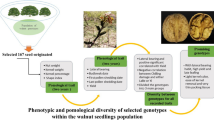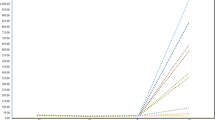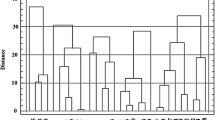Abstract
Plants of white clover (Trifolium repens L.) cultivar Crau, a self-fertile Crau genotype, and nine generations of inbred progeny were raised in sand culture in a glasshouse experiment. Digital images of the root systems were made and root morphological characteristics were determined on all the plants. Root architectural parameters were measured on the Crau parent and the S1, S4, S6, and S9 inbred lines. The clover roots became shorter and thicker with inbreeding but the number of root tips per plant was unchanged. Root architecture (branching pattern) was largely unaffected by inbreeding. It is concluded that inbreeding white clover will lead to shorter, thicker roots, and reduced nutrient uptake efficiency compared with the parent clover. The degree to which these deleterious traits are overcome during the development of F1 hybrids needs to be determined.


Similar content being viewed by others
References
Abberton MT, Michaelson-Yeates TPT, Macduff JH (1998) Characterization of novel inbred lines of white clover (Trifolium repens L.). I. Dynamics of plant growth and nodule development in flowing solution culture. Euphytica 103:35–43
Blamey FPC, Edmeades DC, Edwards DG, Wheeler DM (1991) Evaluation of solution culture techniques for studying aluminium toxicity in plants. In: Wright RJ, Baligar VC, Murrmann RP (eds) Plant soil interactions at low pH. Academic Press, Dordrecht, pp 905–912
Brouwer DJ, Osborn TC (1997) Molecular marker analysis of the approach to homozygosity by selfing in diploid alfalfa. Crop Sci 37:1326–1330
Caradus JR, Woodfield DR (1998) Genetic control of adaptive root characteristics in white clover. Plant Soil 200:63–69
Cousins G, Woodfield D (2006) Effect of inbreeding on herbage yield in white clover. In: Mercer CF (ed) Advances in pasture plant breeding. Grassland Research and Practice Series No. 12. New Zealand Grassland Association, Dunedin, pp 131–134
Crush JR, Care DA, Gourdin A, Woodfield DR (2005a) Root growth media effects on root morphology and architecture in white clover. N Z J Agric Res 48:255–263
Crush JR, Waller JE, Care DA (2005b) Root distribution and nitrate interception in eleven temperate forage grasses. Grass Forage Sci 60:385–292
Edmeades DC, Wheeler DM, Clinton OE (1985) The chemical composition and ionic strength of soil solutions from New Zealand topsoils. Aust J Soil Res 23:151–165
Fitter AH (1985) Functional significance of root morphology and root system architecture. In: Fitter AH, Atkinson D, Read DJ, Usher MB (eds) Ecological interactions in soil. Special Publication of the British Ecological Society No. 4, pp 87–106
Fitter AH (1986) The topology and geometry of plant root systems: influence of watering rate on root system topology in Trifolium pratense. Ann Bot 58:91–101
Fitter AH (1987) An architectural approach to the comparative ecology of plant root systems. New Phytol 106(Suppl):61–77
Fitter AH, Stickland TR, Harvey ML, Wilson GW (1991) Architectural analysis of plant root systems. 1. Architectural correlates of exploitation efficiency. New Phytol 118:375–382
GenStat (2005) 8th edn, version 8.1.0.156. VSN International Ltd., Oxford, Great Britain
Hewitt EJ (1966) Sand and water culture methods used in the study of plant nutrition. Commonwealth bureau of horticulture and plantation crops, Technical Communication 22, 547pp
Holy J, Chloupek O (1999) Influence of inbreeding and heterosis on some indices of N2 fixation in lucerne (Medicago sativa L.). Czech J Genet Plant Breed 35:79–82
Hutchings MJ, De Kroon H (1994) Foraging in plants: the role of morphological plasticity in resource acquisition. Adv Ecol Res 25:159–238
Jackman RH, Mouat MCH (1972) Competition between grass and clover for phosphate. I. Effect of browntop (Agrostis tenuis Sibth.) on white clover (Trifolium repens L.) growth and nitrogen fixation. N Z J Agric Res 15:653–666
Jungk AO (1996) Dynamics of nutrient movement at the soil-root interface. In: Waisal Y, Eshel A, Kafkafi U (eds) Plant roots: the hidden half. Marcel Dekker, New York, pp 529–556
Michaelson-Yeates TPT, Marshall A, Abberton MT, Rhodes I (1997) Self-compatibility and heterosis in white clover (Trifolium repens L.). Euphytica 94:341–348
Michaelson-Yeates TPT, Macduff JH, Abberton MT, Raistrick N (1998) Characterization of novel inbred lines of white clover (Trifolium repens L.). II. Variation in N2 fixation, NO −3 uptake and their interactions. Euphytica 103:45–54
Reader RJ, Jalil A, Grime JP, Spencer RE, Mathews N (1993) Penetration and response to drought. In: Hendry GAF, Grime JP (eds) Methods in comparative plant ecology. Chapman & Hall, London, pp 173–176
Rotili P (1991) The role of selfing in the synthetic and hybrid varieties’ constitution in the forage crops. In: Fodder crops breeding: achievements, novel strategies and biotechnology. Proceedings of the 16th Meeting of the Fodder Crops Section of Eucarpia, Wageningen, The Netherlands, 18–22 November 1990, pp 83–88
Williams WM (1987) Genetics and breeding. In: Baker MJ, Williams WM (eds) White clover. CAB International, Wallingford, pp 343–419
Woodfield DR, Brummer EC (2000) Integrating molecular techniques to maximise the genetic potential of forage legumes. In: Spangenberg G (ed) Molecular forage breeding. Kluwer Academic Publishers, Netherlands, pp 51–65
Yamada T, Fukuoka H, Wakamatsu T (1989) Recurrent selection programmes for white clover (Trifolium repens L.) using self-compatible plants. I. Selection of self-compatible plants and inheritance of a self-compatibility factor. Euphytica 44:167–172
Acknowledgements
Dr J. E. Waller for statistical analysis of the data. Greig Cousins for supplying the inbred clover material.
Author information
Authors and Affiliations
Corresponding author
Rights and permissions
About this article
Cite this article
Nichols, S.N., Crush, J.R. & Woodfield, D.R. Effects of inbreeding on nodal root system morphology and architecture of white clover (Trifolium repens L.). Euphytica 156, 365–373 (2007). https://doi.org/10.1007/s10681-007-9386-6
Received:
Accepted:
Published:
Issue Date:
DOI: https://doi.org/10.1007/s10681-007-9386-6




